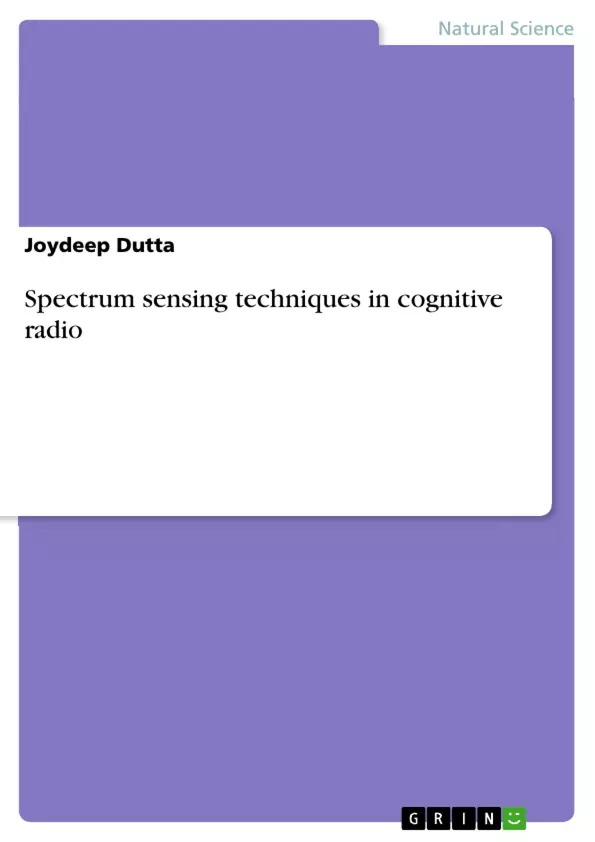Cognitive Radio offers non-interfering use of spectrum which requires three main tasks: Spectrum Sensing, Spectrum Analysis and Spectrum Allocation. The aim of this study is to focus on spectrum sensing in cognitive radio which is a recently introduced technology in order to increase the spectrum efficiency.
Increasing efficiency of the spectrum usage is an urgent need as the number of wireless users is increasing rapidly. Cognitive radio arises to be a good solution to spectral crowding problem by introducing the opportunistic usage of frequency bands that are not heavily occupied by licensed users (Primary user) since they cannot be utilized by users other (Secondary user) than the license owners at the moment. Cognitive radio can sense the spectrum and detect the idle frequency bands, thus secondary users can be allocated in those bands when primary users do not use those in order to avoid any interference to primary user by secondary users. Several Spectrum Sensing Methods proposed in the literature are theoretically analyzed and interpreted in the sense of advantages and drawbacks.
Inhaltsverzeichnis (Table of Contents)
- Introduction
- Introduction and Background
- Outline of the Book
- Introduction to cognitive radio
- Brief History
- Dynamic Spectrum Access (DSA)
- Cognitive Radio (CR)
- Cognitive Radio's Key Benefits
- Cognitive Radio Features
- Spectrum sensing in cognitive radio
- Issues and Challenges in Spectrum Sensing
- Channel Uncertainty
- Noise Uncertainty
- Aggregate Interference Uncertainty
- Sensing Interference Limit
- Different Spectrum Sensing Techniques
- Spectral overlap based energy sensing
- Centralized framework for time-domain sensing
- Analytical interference model
- Compressed sensing based spectrum sensing
- Overview of Compressed Sensing
- Sparsity
- Sensing Matrix
- Sparse Signal Recovery
- Uniqueness Conditions for Minimization Problems
- Mutual Coherence
- Restricted Isometry Property
- Measurement bounds
- Recovery Algorithms
- Compressed Wideband Sensing in Cooperative Cognitive Radio Networks
- Compressed Spectrum Sensing at Individual CRs
- Results
- Subcarrier and power allocation in OFDMA
- Introduction
- OFDM
- OFDM Transmitter
- OFDM Receiver
- OFDMA
- OFDMA Transmitter
- OFDMA Receiver
- Subcarrier Allocation
- system model and problem formulation
- sensible greedy approach
Zielsetzung und Themenschwerpunkte (Objectives and Key Themes)
This book explores the concept of cognitive radio and its application in spectrum sensing techniques, with a particular focus on increasing spectrum efficiency. The primary objective is to provide an overview of cognitive radio technology, analyze different spectrum sensing methods, and examine the challenges and limitations associated with them.
- Efficient spectrum usage in cognitive radio
- Spectrum sensing techniques for cognitive radio
- Energy detection and compressed sensing for cognitive radio
- Challenges and limitations of spectrum sensing
- Performance analysis and comparison of different sensing methods
Zusammenfassung der Kapitel (Chapter Summaries)
Chapter 1 provides a comprehensive introduction to the concept of cognitive radio and the pressing need for efficient spectrum usage. It outlines the main challenges in utilizing the limited spectrum resources and introduces the key aspects of cognitive radio technology, including spectrum sensing, analysis, and allocation. Chapter 2 delves deeper into the history and development of cognitive radio, outlining the principles of Dynamic Spectrum Access (DSA) and exploring the key benefits and features of cognitive radio technology. Chapter 3 focuses specifically on spectrum sensing in cognitive radio, highlighting the various issues and challenges associated with this process, such as channel uncertainty, noise uncertainty, and interference limitations. The chapter also introduces a variety of spectrum sensing techniques, laying the foundation for further analysis.
Schlüsselwörter (Keywords)
The primary focus of this book is on cognitive radio, spectrum sensing, dynamic spectrum access, energy detection, compressed sensing, wireless communication, and spectrum efficiency.
- Arbeit zitieren
- Joydeep Dutta (Autor:in), 2022, Spectrum sensing techniques in cognitive radio, München, GRIN Verlag, https://www.grin.com/document/1169156



